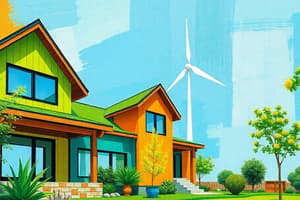Podcast
Questions and Answers
What is the main goal of energy-efficient designs in green construction?
What is the main goal of energy-efficient designs in green construction?
- Focus solely on aesthetic appeal
- Increase the use of traditional energy sources
- Minimize energy consumption and utilize renewable energy (correct)
- Eliminate the use of insulation materials
Which factor is essential in passive solar design?
Which factor is essential in passive solar design?
- Thermal mass and orientation (correct)
- Window size and shape
- Type of insulation used
- Utility grid connections
How do energy-efficient windows help in reducing energy consumption?
How do energy-efficient windows help in reducing energy consumption?
- By enhancing thermal mass
- Through single glazing technology
- By increasing air infiltration
- Using double or triple glazing to reduce heat transfer (correct)
What role do smart thermostats play in energy-efficient HVAC systems?
What role do smart thermostats play in energy-efficient HVAC systems?
Which insulation material is considered high-performance for energy efficiency?
Which insulation material is considered high-performance for energy efficiency?
Which of the following is a strategy to enhance natural ventilation in buildings?
Which of the following is a strategy to enhance natural ventilation in buildings?
What benefit do solar water heaters provide in green construction?
What benefit do solar water heaters provide in green construction?
Which daylighting technique can effectively reduce reliance on artificial lighting?
Which daylighting technique can effectively reduce reliance on artificial lighting?
Flashcards are hidden until you start studying
Study Notes
Energy-efficient Designs in Green Construction
-
Definition: Designs that minimize energy consumption and utilize renewable energy sources.
-
Key Principles:
- Passive Solar Design: Maximizes natural light and heat from the sun; includes orientation, window placement, and thermal mass.
- Natural Ventilation: Enhances airflow through the building, reducing the need for mechanical cooling.
-
Insulation:
- High-performance Insulation: Materials that reduce heat loss or gain; includes fiberglass, cellulose, and spray foam.
- Air Sealing: Minimizes air leaks to improve overall energy efficiency.
-
Energy-efficient Windows:
- Double or Triple Glazing: Reduces heat transfer; argon or krypton gas fills can increase efficiency.
- Low-emissivity (Low-E) Coatings: Reflects infrared radiation while allowing visible light to enter.
-
Heating, Ventilation, and Air Conditioning (HVAC):
- Energy-efficient Systems: Use of high-efficiency furnaces, heat pumps, and air conditioners (SEER ratings).
- Smart Thermostats: Optimize heating and cooling schedules based on occupancy.
-
Lighting:
- LED or CFL Lighting: Significant energy savings compared to traditional incandescent bulbs.
- Daylighting Techniques: Use of skylights, clerestory windows, and light tubes to reduce reliance on artificial lighting.
-
Renewable Energy Integration:
- Solar Panels: Photovoltaic systems that convert sunlight into electricity.
- Wind Turbines: Can be integrated into buildings to supplement energy needs.
-
Water Heating:
- Tankless Water Heaters: Provide hot water on demand, reducing energy waste.
- Solar Water Heaters: Utilize the sun’s energy to heat water efficiently.
-
Building Orientation:
- Site Planning: Proper alignment with the sun's path to maximize solar gain and minimize energy use.
-
Energy Modeling:
- Simulation Tools: Use of software to predict energy consumption and optimize building design.
-
Regulatory Standards:
- LEED Certification: A widely recognized green building certification focusing on energy efficiency and sustainable practices.
- Energy Star Ratings: Programs that certify products and buildings for energy efficiency.
-
Lifecycle Assessment:
- Building Materials: Evaluation of materials for energy consumption during manufacturing, transportation, and disposal.
These energy-efficient design strategies are integral to green construction, aiming to create sustainable, low-impact buildings that reduce environmental footprints while enhancing occupant comfort.
Energy-efficient Designs in Green Construction
- Designs prioritize energy conservation and incorporation of renewable resources.
Key Principles
-
Passive Solar Design: Utilizes orientation, window arrangement, and thermal mass to harness sunlight for natural heating and lighting.
-
Natural Ventilation: Promotes airflow, decreasing dependence on mechanical cooling systems.
Insulation Techniques
-
High-performance Insulation: Employs advanced materials like fiberglass, cellulose, and spray foam to limit heat transfer.
-
Air Sealing: Reduces unwanted air leaks to enhance energy efficiency throughout the building envelope.
Energy-efficient Windows
-
Double or Triple Glazing: Incorporates multiple panes with argon or krypton gas between them to minimize heat transfer.
-
Low-emissivity (Low-E) Coatings: Reflects infrared radiation, keeping indoor spaces cooler while allowing visible light in.
Heating, Ventilation, and Air Conditioning (HVAC)
-
Energy-efficient Systems: Features high-efficiency furnaces and heat pumps, identified by high Seasonal Energy Efficiency Ratio (SEER) ratings.
-
Smart Thermostats: Adjust heating and cooling automatically based on usage patterns, optimizing energy use.
Lighting Solutions
-
LED or CFL Lighting: Consumes significantly less energy compared to traditional incandescent bulbs, leading to lower energy bills.
-
Daylighting Techniques: Incorporates natural light through skylights and other openings, reducing reliance on artificial lighting.
Renewable Energy Integration
-
Solar Panels: Use photovoltaic technology to convert sunlight into electricity, supporting energy independence.
-
Wind Turbines: Can supplement building energy needs, providing an additional renewable energy source.
Water Heating Innovations
-
Tankless Water Heaters: Supply hot water only as needed, minimizing energy waste associated with traditional storage systems.
-
Solar Water Heaters: Utilize sunlight to efficiently heat water, lowering energy costs.
Building Orientation and Site Planning
- Proper Site Alignment: Orientation with the sun’s path to maximize natural solar gain while minimizing energy costs.
Energy Modeling Techniques
- Simulation Tools: Software aids in predicting energy demand and refining building designs for optimal efficiency.
Regulatory Standards
-
LEED Certification: A prominent green building certification program that emphasizes energy efficiency and sustainability.
-
Energy Star Ratings: Certifies energy-efficient products and buildings, promoting environmental standards.
Lifecycle Assessment
-
Evaluation of Building Materials: Analyzes energy consumption related to material sourcing, manufacturing, transport, and waste management to promote sustainable choices.
-
Focus on these strategies supports the development of eco-friendly buildings that reduce environmental impacts and enhance occupant well-being.
Studying That Suits You
Use AI to generate personalized quizzes and flashcards to suit your learning preferences.




